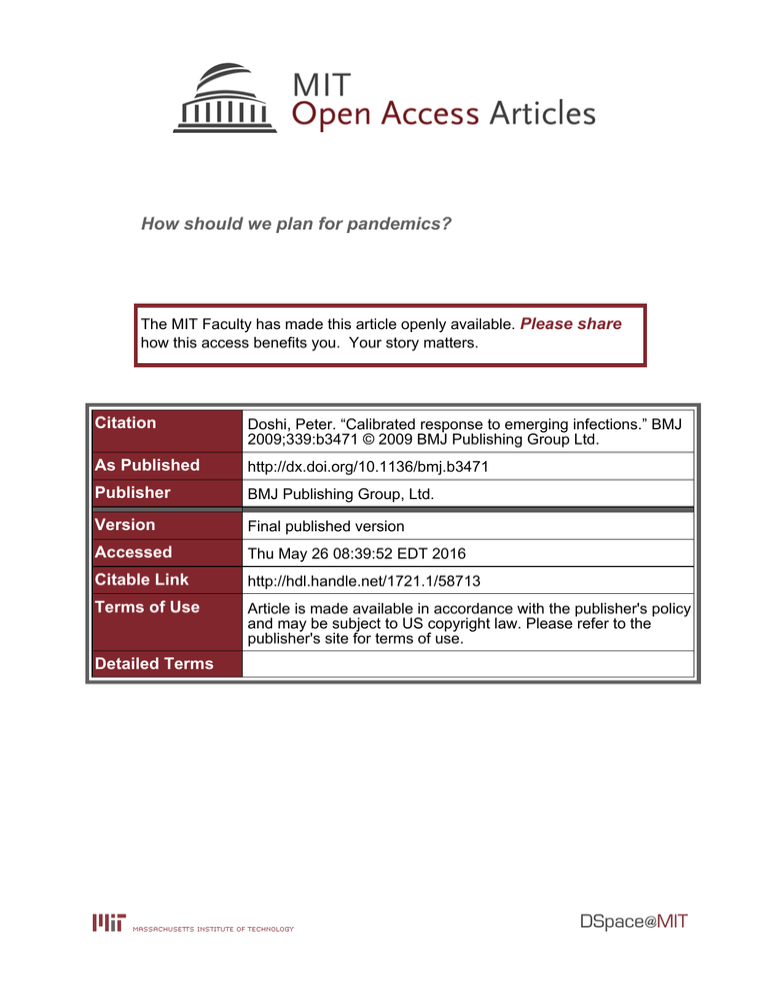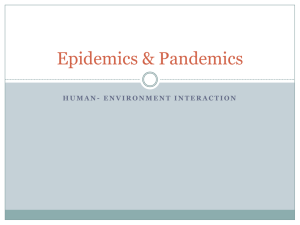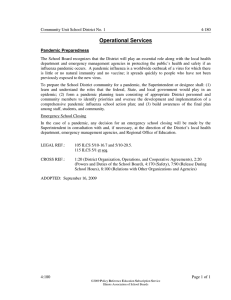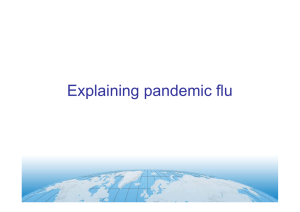How should we plan for pandemics? Please share
advertisement

How should we plan for pandemics? The MIT Faculty has made this article openly available. Please share how this access benefits you. Your story matters. Citation Doshi, Peter. “Calibrated response to emerging infections.” BMJ 2009;339:b3471 © 2009 BMJ Publishing Group Ltd. As Published http://dx.doi.org/10.1136/bmj.b3471 Publisher BMJ Publishing Group, Ltd. Version Final published version Accessed Thu May 26 08:39:52 EDT 2016 Citable Link http://hdl.handle.net/1721.1/58713 Terms of Use Article is made available in accordance with the publisher's policy and may be subject to US copyright law. Please refer to the publisher's site for terms of use. Detailed Terms ANALYSIS How should we plan for pandemics? WHO has revised its definition of pandemic flu in response to current experience with A/H1N1. Peter Doshi argues that our plans for pandemics need to take into account more than the worst case scenarios The current flu pandemic raises a public health policy question that could have been asked after the emergence of severe acute respiratory syndrome (SARS): what is the proper response to clinically mild or epidemi‑ ologically limited (small number) outbreaks caused by new viruses? Over the past four years, pandemic preparations have focused on responding to worst case scenarios. As a result, officials responded to the H1N1 outbreak as an unfolding disaster. Measures were taken that in hindsight may be seen as alarmist, overly restrictive, or even unjusti‑ fied. Assumptions about the nature of emerg‑ ing infections along with advanced laboratory surveillance have changed the way we under‑ stand epidemics and we need a new frame‑ work for thinking about epidemic disease. Predictions that missed the mark Before the arrival of novel A/H1N1 virus, pan‑ demics were said to occur when a new sub‑ type of influenza virus to which humans have no immunity enters the population, begins spreading widely, and causes severe illness.1 2 Reference was often made to the catastrophic pandemic of 1918 and the ongoing threat of highly pathogenic avian influenza H5N1 that has killed over half of the 456 people with recorded infection since 1997. Without proper preparation, “The loss of human life even in a mild pandemic will be devastating, and the cost of a world economy in shambles for several years can only be imagined,” one highly cited article concluded in 2005.3 The large sums of public money spent on pandemic preparedness (over $7bn (£4bn; €5bn) in the US) underlined the seriousness of the threat, and often repeated phrases such as “not a question of IF a pan‑ demic will happen, but WHEN”4 characterised the next flu pandemic as a high probability, high consequence event. But the 2009 pandemic, taken as a whole, bears little resemblance to the forecasted pan‑ demic. Pandemic A/H1N1 virus is not a new subtype but the same subtype as seasonal A/ H1N1 that has been circulating since 1977. Fur‑ thermore, a substantial portion of the population may have immunity. The US Centers for Dis‑ ease Control and Prevention (CDC) found that 33% of those aged over 60 had cross reactive antibody to novel A/H1N1,5 which may explain Changing views of pandemic flu, before and after emergence of influenza A/H1N1 virus Aspect One line summary Before A/H1N1 WHO 2003-9: “An influenza pandemic occurs when a new influenza virus appears against which the human population has no immunity, resulting in epidemics worldwide with enormous numbers of deaths and illness”10 Virus and immunity WHO 2005:“Most people will have no immunity to the pandemic virus”1 Impact (health, social, economic) Since A/H1N1 WHO: “An influenza pandemic may occur when a new influenza virus appears against which the human population has no immunity”10 WHO: “The vulnerability of a population to a pandemic virus is related in part to the level of preexisting immunity to the virus”12 US CDC 1997: “When antigenic shift occurs, US CDC: “Cross-reactive antibody [to A/H1N1] was the population does not have antibody detected in 6%-9% of those aged 18-64 years and 13 protection against the virus” in 33% of those aged >60 years”5 WHO 2005: “Large numbers of deaths WHO: “H5N1 has conditioned the public to equate will occur . . . WHO has used a relatively an influenza pandemic with very severe disease conservative estimate—from 2 million to and high mortality. Such a disease pattern is by 7.4 million deaths . . .Economic and social no means inevitable during a pandemic. On the 1 disruption will be great” contrary, it is exceptional”14 CDC 1997: “The hallmark of pandemic CDC: “There are some pandemics that look very influenza is excess mortality”13 much like a bad flu season”8 Canada 2006: “An influenza pandemic results Canada: “An influenza pandemic does not if many people around the world become ill and necessarily cause more severe illness than die from such a [new form of influenza] virus”15 seasonal influenza”9 BMJ | 12 september 2009 | Volume 339 why cases have been rare in elderly people. There is also far less certainty today regard‑ ing the severity of the threat of pandemic flu. Experts are unsure that the 2009 pandemic— which the World Health Organization pres‑ ently characterises as moderate6—will be any worse than seasonal flu.7‑9 Since the emer‑ gence of novel A/H1N1, descriptions of pan‑ demic flu (both its causes and its effect) have changed to such a degree that the difference between seasonal flu and pandemic flu is now unclear (table).10 WHO, for example, for years defined pandemics as outbreaks causing “enormous numbers of deaths and illness,”10 but in early May, removed this phrase from the ­definition.11 On 29 April 2009, one week after news of the outbreak first surfaced, WHO declared a phase 5 pandemic alert (the highest threat level short of global pandemic), urging all countries to “immediately activate their pandemic pre‑ paredness plans.”16 Epidemiological informa‑ tion at this time was mixed, suggesting a severe disease in Mexico but mild everywhere else. Actions were thus taken in an environment of high public attention and low scientific certainty.17 18 Some countries erected port of entry quarantines. Others advised against nonessential travel to affected areas. Some closed schools and businesses. Many held daily press briefings. The wisdom of many of these actions, particularly in response to what has largely been a clinically mild illness, will undoubtedly be debated in the future. What these actions more clearly show, however, is that the public health response to, as well as impact and social experience of a pandemic, is heavily influenced by longstanding planning assumptions about the nature of pandemics as disaster scenarios. Laboratory surveillance drives concern One assumption concerned the importance of laboratory surveillance data to help identify and characterise cases, especially during the initial phases of a pandemic.19 This intensive use of the laboratory to understand the epidemiology of an epidemic disease is a product of our time. 603 ANALYSIS Total No of respiratory specimens tested Influenza isolates (all subtypes) Percentage positive for influenza 30 30 First US cases A/H1N1 Ju n Type 3 (eg, 1968 and 1957 pandemics) Mostly mild Type 1 (eg, 1918 “Spanish flu” pandemic) Severity Type 4 (eg, H1N2, since 1988) Mostly severe Type 2 (eg, H5N1 “bird flu,” since 1997) Infects few 21 Ju n 7 M M ay ay 24 r 10 Ap 26 Ap 12 M 29 ar M 15 M 1 Fe Fe 15 1 18 4 r 0 ar 0 ar 10 b 10 b 20 Ja n 20 Infects many Distribution 40 Percentage 40 Ja n No of specimens (000s) US declares public health emergency Fig 1 | CDC data on numbers of respiratory specimens testing positive for influenzaWeek virusbeginning in US, January-June 2009 (www.cdc.gov/flu/weekly/weeklyarchives2008-2009/data/whoAllregt31.htm) Fig 2 | Proposed classification of impact of new infectious diseases During the 1918 pandemic, although investiga‑ tors looked hard for the cause, no distinction was made between pandemic influenza and seasonal influenza as is done today. Influenza was simply influenza—or what today would probably be called influenza-like illness—and diagnosed on clinical grounds. Much has changed since then. When researchers at the CDC reported the first two cases of A/H1N1 swine flu on 21 April 2009 it was not the clinical illness that worried them— both patients had recovered uneventfully by the time of the report—but the fact that human to human transmission was suspected in two laboratory confirmed cases of novel influenza virus infection.20 On 26 April, with 20 cases and no deaths in the US, the Department of Health and Human Services declared a nationwide public health emergency.21 The subsequent increase in laboratory testing was unprecedented (fig 1). The sudden emphasis on laboratory testing for H1N1 in the first weeks of the outbreak, particularly in the US, produced what I call concern bias, in which concern and anxiety may drive events more than the disease itself. Concern bias confounds the interpretation of data in important ways. The rapid increase in virological testing amplified the perceived prevalence of A/H1N1 and simultaneously minimised the role other agents may have played in causing the same symptoms. After the declaration of a public health emergency, the percentage of respiratory specimens testing positive for influenza viruses increased for eight consecutive weeks to a peak of 40% (fig 1). This increase, however, may only in part reflect a true increase in prevalence of influenza. It may also be due to behavioural changes in the way respiratory specimens were taken, tested, and reported on.22 Laboratories were overwhelmed with a however, depends on the future course of the event. 604 large volume of respiratory specimens, often from patients who under ordinary circum‑ stances would not have had a specimen taken (an extension of the “worried well” effect).23 The early screening out of samples unlikely to be A/H1N1 positive (for example, specimens positive for influenza B by rapid diagnostic testing at the bedside) is one way to reduce the workload at more sophisticated laboratories focused on confirmatory testing. However, this is likely to lead to overstatement of the proportion of influenza-like illness caused by A/H1N1 reported by laboratories. By con‑ trast, in Sweden, of 79 travellers meeting the suspected novel H1N1 case definition (flulike symptoms and recent travel to the US or Mexico) between 24 April and 10 June, only four had A/H1N1 infection. Non-influenza viruses were diagnosed in 40 samples, and 32 had unknown cause.24 As cause can affect treatment decisions, timely laboratory surveillance is essential. The apparent discordance between Swedish and US laboratory data suggests that without on­going randomised sampling, it will be diffi‑ cult to understand the effect of any single aetio‑ logical agent that causes clinically non-specific symptoms, such as influenza-like illness. The high concern also makes it difficult to determine whether this epidemic revealed itself or whether its presence came to light only because of heightened awareness triggered by official announcements. During 19-25 April— nearly three weeks after the first two US cases and when the virus was presumably spreading— respiratory specimen testing was tapering off at laboratories around the country (fig 1). But in the week after the emergency declaration on 26 April, reports increased nearly sevenfold. Large and geographically dispersed surveil‑ lance systems allow us to see more than ever. Whether they do us more good than harm, Calibrating the response to the threat If the 2009 influenza pandemic turns severe, far exceeding the impact of seasonal influenza, early and enhanced surveillance may prove to have bought critical time to prepare a vaccine that could reduce morbidity and mortality. The negative effect on the pork and travel industries, the discrimination some felt for the “crime” of catching a new disease, the ­mandatory isolation of uninfected people, and the substantial pub‑ lic money invested into pandemic preparations will probably be said to, on balance, have been far better than being caught unprepared for a severe pandemic. But if this pandemic does not increase in severity, it may signal the need to reassess both the risk assessment and risk management strat‑ egies towards emerging infectious diseases. The SARS outbreak showed that large numbers of infected people are not necessary to generate concern and fear over disease. The SARS virus is known to have affected only 8096 people globally, but the fear of infection, involuntary quarantine, travel restrictions and subsequent political antagonisms, and at least $18bn in losses were felt by far more. It was not the virus but the response to it that caused these social and economic harms. Future responses to infectious disease may benefit from a risk assessment that broadly conceives of four types of threat based on the disease’s distribution and clinical severity (fig 2). Infectious diseases, whether caused by new or old pathogens, may infect few people or they may infect many (distribution). Further‑ more, these pathogens can produce a clinical illness of variable severity, from mostly mild (or even asymptomatic) illness at one extreme to mostly severe illness at the other. ­Distribution BMJ | 12 september 2009 | Volume 339 ANALYSIS and severity are independent variables and together produce a matrix of four possible impacts. A single, one size fits all public health strategy cannot respond to the vastly different challenges these four clinical-epidemiological combinations present. The commonality between the SARS epi‑ demic and the present flu pandemic (at least so far) is that both were responded to with a public health strategy that may be more suit‑ able to an epidemic of severe disease infecting many people (type 1). But SARS (which killed around 10% of infected people) was a type 2 epidemic (infecting few, mostly severe disease), and the H1N1 pandemic may prove to be type 3 (affecting many, mostly mild). Recent histori‑ cal evidence suggests that most new viruses have not constituted type 1 threats. While the 1918 pandemic surely qualifies as type 1, the 1957 and 1968 pandemics do not. Most peo‑ ple did not even notice the 1968 pandemic,25 and the recorded mortality in both pandem‑ ics was similar to that in contemporary nonpandemic influenza seasons.26 Despite this, pandemic preparedness strategies have largely considered only type 1 (catastrophic) epidem‑ ics. Public health responses not calibrated to the threat may be perceived as alarmist, eroding the public trust and resulting in people ignor‑ ing important warnings when serious epidemics do occur. Advanced laboratory capabilities allow us to track epidemics at an unprecedented level of detail. Such information must not be allowed to obscure a broader perspective that places importance on the severity of the clinical illness most people experience and knowledge of how many people are being infected. The s­uccess answers to endgames, p 639. For long answers use advanced search at bmj.com and enter question details Statistical question Intention to treat analyses c Kayser-Fleischer rings, visible as a greenish ring at the outer corneal surface (arrow) of public health strategies today depends as much on technical expertise as it does on media relations and communications. Strategies that anticipate only type 1 epidemics carry the risk of doing more harm than they prevent when epidemiologically limited or clinically mild epi‑ demics or pandemics occur. Peter Doshi doctoral student, Program in History, Anthropology, and Science, Technology and Society, E51-070, Massachusetts Institute of Technology, 77 Massachusetts Avenue, Cambridge, MA 02139, USA pnd@mit.edu Accepted: 22 August 2009 I thank Danielle Mancini, Yuko Hara, and Tom Jefferson for helpful comments. Competing interests: None declared. Provenance and peer review: Not commissioned; externally peer reviewed. 1 World Health Organization. Ten things you need to know about pandemic influenza. 2005. www.who.int/csr/ disease/influenza/pandemic10things/en/. 2 US Department of Health and Human Services. Influenza pandemics: how they start, how they spread, and their potential impact. 2005www.dhhs.gov/nvpo/pandemics/ flu2.htm. 3 Osterholm MT. Preparing for the next pandemic. N Engl J Med 2005;352:1839-42. 4 US Department of Health and Human Services. Pandemic flu basics. 2007 www.pandemicflu.gov/takethelead/ fact_sheet_basics.pdf. 5 US Centers for Disease Control and Prevention. Serum crossreactive antibody response to a novel influenza A (H1N1) virus after vaccination with seasonal influenza vaccine. MMWR Morb Mortal Wkly Rep 2009;58:521-4. 6 Chan M. Transcript of statement by Margaret Chan, director-general of the World Health Organization, 11 June 2009. www.who.int/mediacentre/influenzaAH1N1_ presstranscript_20090611.pdf. 7 WHO. Transcript of virtual press conference with Gregory Hartl, WHO spokesperson for epidemic and pandemic diseases, and Dr Keiji Fukuda, assistant director-general ad interim for health security and environment, World Health Organization, 7 May 2009. www.who.int/mediacentre/ influenzaAH1N1_prbriefing_20090507.pdf. 8 US Department of Health and Human Services. H1N1 flu update with HHS sec Kathleen Sebelius [video] 30 April 2009. www.pandemicflu.gov/secretarywebcast.html. 9 Government of Canada. H1N1 flu virus: general information. www.phac-aspc.gc.ca/alert-alerte/swine-porcine/faq_rg_ swine-eng.php. 10 WHO. Pandemic preparedness. http://web.archive.org/ web/20050207101237/http:/www.who.int/csr/disease/ influenza/pandemic/en/ 11 Cohen E. When a pandemic isn’t a pandemic. CNN 2009 May 4. http://edition.cnn.com/2009/HEALTH/05/04/swine.flu. pandemic/index.html. 12 WHO. Considerations for assessing the severity of an influenza pandemic. Wkly Epidemiol Rec 2009;84(22):197-202. 13 US Centers for Disease Control and Prevention. Emerging infections: influenza pandemic facts. http://web.archive. org/web/20050503194920/http://www.cdc.gov/od/oc/ media/pressrel/panfacts.htm. 14 Chan M. World is better prepared for influenza pandemic. WHO, 2009 www.who.int/dg/speeches/2009/asean_ influenza_ah1n1_20090508/en/index.html. 15 Public Health Agency of Canada. Highlights from the Canadian pandemic influenza plan for the health sector: preparing for an influenza pandemic, the Canadian health perspective. 2006. www.phac-aspc.gc.ca/cpip-pclcpi/hl-ps/ pdf/CPIP-highlights-2006_e.pdf. 16 Chan M. Influenza A(H1N1) 29 Apr 2009. www.who.int/ mediacentre/news/statements/2009/h1n1_20090429/ en/print.html. 17 Lipsitch M, Riley S, Cauchemez S, Ghani AC, Ferguson NM. Managing and reducing uncertainty in an emerging influenza pandemic. N Engl J Med 2009;361:112-5. 18 Fineberg HV, Wilson ME. Epidemic science in real time. Science 2009;324:987. 19 WHO. WHO global influenza preparedness plan. 2005. www. who.int/csr/resources/publications/influenza/WHO_CDS_ CSR_GIP_2005_5.pdf. 20 US Centers for Disease Control and Prevention. Swine influenza A (H1N1) infection in two children—Southern California, March-April 2009. MMWR Morb Mortal Wkly Rep 2009;58(dispatch):1-3. 21 US Department of Health and Human Services. HHS declares public health emergency for swine flu. Press release, 26 Apr 2009. www.hhs.gov/news/ press/2009pres/04/20090426a.html. 22 US Centers for Disease Control and Prevention. FluView: 2008-2009 Influenza Season Week 19 ending May 16, 2009.www.cdc.gov/flu/weekly/weeklyarchives2008-2009/ weekly19.htm. 23 Park M. “Walking well” flood hospitals with—or without—flu symptoms. CNN 2009 May 2. www.cnn.com/2009/ HEALTH/05/02/worried.well.hospitals/index.html. 24 Follin P, Lindqvist A, Nyström K, Lindh M. A variety of respiratory viruses found in symptomatic travellers returning from countries with ongoing spread of the new influenza A(H1N1)v virus strain. Eurosurveillance 2009;14. www. eurosurveillance.org/ViewArticle.aspx?ArticleId=19242. 25 Barry JM. Lessons from the 1918 flu. Time 2005 Oct 9:96. 26 Doshi P. Trends in recorded influenza mortality: United States, 1900-2004. Am J Public Health 2008;98:939-45. Cite this as: BMJ 2009;339:b3471 See RESEARCH, pp 618, 619 CASE REPORT Investigating infertility 1 Investigate infertility by taking a detailed history for both partners and performing semen analysis in the man. In the woman, irregular menstrual cycles, hirsutism, and suspected polycystic ovaries warrant hormonal investigations. Measure follicle stimulating hormone, luteinising hormone, testosterone, thyroid function, and prolactin to establish the cause of irregular periods. Request tumour markers in view of the free fluid and the complex mass in the left ovary. 2 Large and complex cystic lesions in premenopausal women require follow-up sonography or physical examination to assess for interval decrease in size. The most common persistent lesions in premenopausal women are dermoids and endometriomas, although malignancy should be ruled out. Magnetic resonance imaging may provide a diagnosis in persistent complex masses. 3 Metformin as a primary treatment in polycystic ovary syndrome does not improve fertility. Picture Quiz Eye sign in an 18 year old man with psychosis 1 The eye sign shown is Kayser-Fleischer rings—greenish discoloration at the outer corneal circumference. This abnormality was named after ophthalmologists Bernhard Kayser and Bruno Fleischer, who described the sign independently in the early 1900s. The rings were later recognised to be copper deposits and diagnostic of Wilson’s disease. 2 The combination of psychosis, extrapyramidal features (dystonia), and Kayser-Fleisher rings is BMJ | 12 september 2009 | Volume 339 classic for Wilson’s disease. A positive family history, low serum ceruloplasmin, high 24 hour urinary copper excretion, high liver copper, and the results of brain magnetic resonance imaging will support the diagnosis. 3 Untreated Wilson’s disease is fatal. Early diagnosis and lifelong copper chelation, with close clinical monitoring, are essential. The chance of neurological recovery is high. 605





